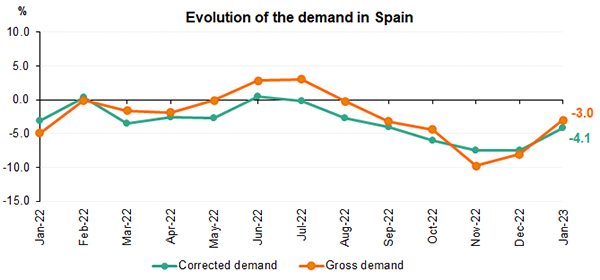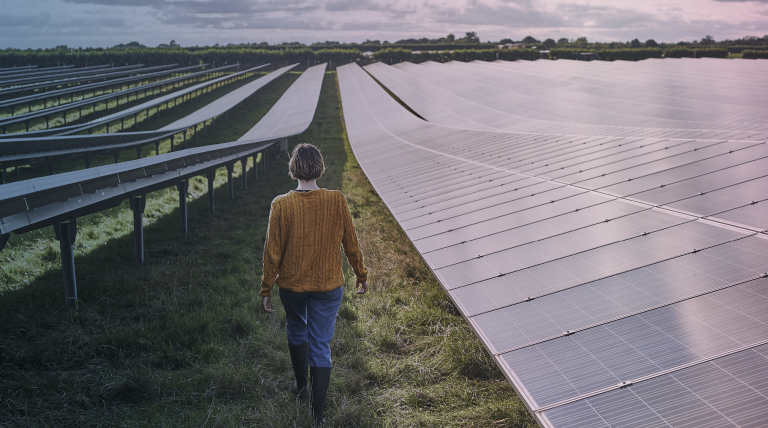For 40 years, we've been driving our country's economic and social progress. Four decades shaping Spain.
Demand for electricity in Spain fell 4.1% in January
- Renewable energy production accounted for 57.4% of Spain’s generation mix in January, registering 13,742 GWh, the highest monthly production since records began.
- Additionally, zero-carbon energy technologies also broke their own all-time monthly high by producing 18,827 GWh in January. The contribution of these technologies accounted for 80% of the monthly generation mix.
Electricity demand in Spain in January stood at 22,052 GWh, down 3% year-on-year. After having factored in the influence of seasonal and working patterns, demand fell by 4.1%.

Renewable energy generation during the month was 40.9% higher than in January 2022, reaching a record 13,742 GWh of monthly generation, thus achieving a share of 57.4% of the total generation mix nationwide.
With the boost from renewables, monthly production obtained using zero-carbon energy technologies also registered a new all-time high of 18,827 GWh, more than 80% of total generation in Spain, and reached levels of up to 90.7% during some hours of the month.
The favourable weather conditions in January, with constant and moderate winds, contributed to making wind power the leading source of electricity production with an overall share of 31.5% of the monthly generation mix according to provisional data available at the time of this press release. This technology has increased its monthly production by 39.2% compared to January 2022 and reached 7,537 GWh. Wind power technology was the leading source of energy in January in Spain, and, actually, it was responsible for more than 50% of the daily generation mix on specific two days, reaching a new all-time high on 8 January with a share of 53.1% of the generation mix.
Solar photovoltaic, with 1,668 GWh recorded in January, increased its production by 6.3% year-on-year, reaching a 7% share of the total generation mix.
Hydroelectric power generation, which had been contributing little to the Spanish generation mix for several months, increased by 93.8% in January compared to the same month in 2022, reaching 4,042 GWh, representing a share of 16.9% of the total mix.
Demand for electricity in the peninsular system falls by 3.2%
Demand for electrical energy on the Spanish mainland stood at 20,834 GWh, down 3.2% year-on-year, a variation that is 4.4% lower after having factored in the influence of seasonal and working patterns.
The renewable power generation fleet on the Spanish mainland as a whole accounted for nearly 60% of the total mix in January, according to provisional data available at the time of this press release. This data represents an all-time monthly high production of 13,558 GWh, 40.6% more than in the same month last year. Generation obtained using zero-carbon energy technologies accounted for 83.1% of the total.
The energy generation mix in January was also led by wind power, which accounted for 32.4% of the total, with a total production of 7,403 GWh during the month, up 38.3% year-on-year.
Demand for electricity in the Balearic Islands and the Canary Islands
Electricity demand in the Balearic Islands in January is estimated at 453,756 MWh, down 2.4% year-on-year. After having factored in the influence of seasonal and working patterns the adjusted monthly demand registered a fall of 2.5% .
In terms of generation, combined cycle, with a share of 75.7% of the energy produced in the Balearic Islands, was the leading energy source on the islands in January. For its part, renewable energy obtained using zero-carbon energy technologies in the Balearic Islands generated 8.1% of the total. In addition, during this month, the submarine link between the Spanish mainland and Majorca contributed to covering 27.2% of the electricity demand in the Balearic Islands.
Meanwhile, in the Canary Islands, the demand for electricity stood at 731,584 MWh, up 2.6% year-on-year. Once again, after having factored in the influence of seasonal and working patterns, demand was 2.2% higher than in the same month last year.
With regard to electricity generation in the Canary Islands, combined cycle, with 39.4% of the total generation, was also the leading technology in January, while renewables and zero-carbon energy technologies increased by 95.7% year-on-year and reached a share of 21.5% of production, with wind power accounting for 18.3%.
Consult our Daily Balance Report for more information on the National, Peninsular, Balearic Islands and Canary Islands electricity systems as at the close of January.












